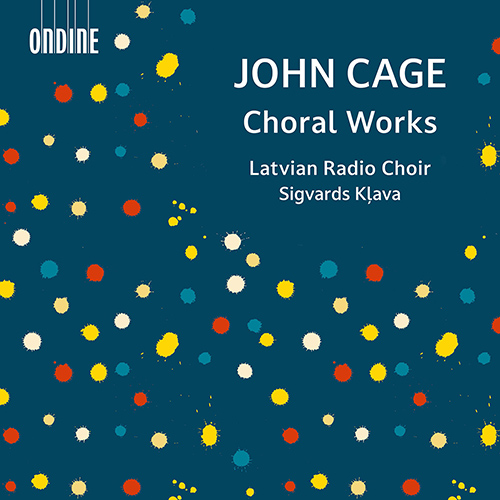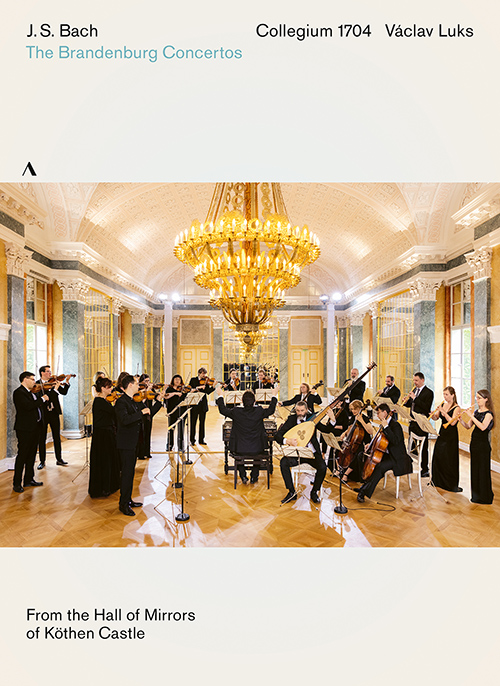In addition to its own wide-reaching monthly new releases (see www.naxos.com/newreleases.asp), Naxos also distributes several leading labels in many countries around the world. Here is a choice selection of recent releases from some of these distributed labels.
After 30 years – and more than 70 international releases – with recording companies like Philips/Polygram, RCA/BMG, and EMI, Danish recorder virtuoso Michala Petri and distinguished guitarist, lutenist, and composer Lars Hannibal launched their own recording label, OUR Recordings, on 1st November 2006. The idea was to have complete artistic and creative freedom and responsibility to record what they felt was necessary and consistent with their desire to explore new challenges.
Several ambitious cycles have captivated collectors and critics alike. Significant titles include East Meets West series and Michala Petri’s ongoing endeavour to expand the capabilities of her instrument including her Recorder Concertos from various countries and incredible pieces for the recorder and choir. Further impressive series include music by late Danish composer Axel Borup-Jørgensen and releases with Danish National Vocal Ensemble.
‘Esfahani’s sparkle and energy meet their match in the spry sounds of the Aarhus Symphony Orchestra, conducted by the Finnish maverick Leif Segerstam. All in all, I emerged from listening feeling refreshed and very clean’
– The Times (London)
‘The recording is impeccable, the intended balance achieved spectacularly…Recommended on every conceivable level. The confluence of composition, performance and recording here is beyond criticism’
– Fanfare ★★★★★
‘This version of Messiaen’s early masterpiece contains liner notes unlike any I’ve seen. Most descriptions of the work’s well-known genesis in a prison camp present it all from a distance. Writer Jens Christian Grondahl emotes as much as recounts, his prose inhabiting a timeless present to match the music, entering into the performers’ psychologies, actions and emotions with stunningly simple fluidity. To read his prose-poetry brings heart-breaking inspiration similar to that of the performance, and the whole package is now one of the finest versions on record.’
– Fanfare ★★★★★
‘The four musicians present themselves as a homogeneous (and technically expected high-class) ensemble. Overall, the reading of the quartet is lyrical, rather slim, avoiding extremes (also in the choice of tempi), placing the melodic flow of the work in the foreground.’
– Klassik Heute
Michael Jary’s Ich weiß, es wird einmal ein Wunder gescheh’n (I know there will be a miracle one day) and Davon geht die Welt nicht unter (The world won’t end because of this), Theo Mackeben’s Du hast Glück bei den Frau’n, Bel Ami! (You’re lucky with the ladies, bel ami!), Lothar Brühne’s Ich brech’ die Herzen der stolzesten Frau’n (I break the hearts of the proudest women), and Friedrich Schröder’s Ich tanze mit dir in den Himmel hinein (I’ll dance to heaven with you) are just some of the sound film hits that are still popular today and that, if not commissioned, were later perfidiously misused by National Socialists for propaganda purposes. Terms such as ‘propaganda film’ or ‘morale-boosting film’ accompany the programme presented on this album as the ugly downside of what were sometimes brilliant musical creations. The Münchner Rundfunkorchester, founded in 1952, has played individual titles from these films again and again in very different scorings and arrangements over the course of its 70-year history. This album was produced as a studio recording in October 2021, and all the sound film hits were played in their purely orchestral form – thus revealing the core of the individual compositions while allowing the necessary historical distance.
Music by the marvellous, but unjustly underrated composer and ‘Aural Alchemist’ Charles Koechlin is invariably a real discovery. ‘Koechlin can daub with notes as Seurat daubed with bright pigments on canvas; [he] could, whenever he wished, bathe his music in the impressionist glories of Debussy and Ravel or give it the delicacy of Fauré and then toughen it up with some Roussel-like grinding rhythms.’ (Robert Reilly) He is an impressionist dreamboat. With a title like The Seven Stars’ Symphony, and following so closely on the heels of the equally enchanting Vers la voûte étoilée (Toward the Vault of the Stars), one might think the work was some spectacular, colourist, celestial bonanza. In fact, it’s Koechlin’s ode to his favourite film stars – but no less bewitching for that.
Vivaldi wrote many concertos; his series of four concerti, The Four Seasons, first published in 1725, is among the most celebrated works for violin. The beloved Baroque virtuoso composed these timeless pieces depicting the four seasons, hence the nickname Summer, Winter, Autumn, and Spring. Along with this, written at the top of the musical score, are four sonnets crafted about these seasons, printed and then repeated line by line on the corresponding musical episodes they represent. Vivaldi’s genius and creativity gushing forth from this beautiful music brought the Italian Baroque concerto to its zenith.
The evident attention of Vivaldi to extra-musical references reflects the innovative techniques he intended to take at the time. His success paved the way for the Venetian styled concerti to be recognised throughout Europe and to which Evaristo Felice Dall’Abaco adapted from 1704 until he died in 1742 while serving at the Hofkapelle in Munich. Compared to his other works, Dall’Abaco’s Op. 6 exhibits a more consistent concept, provided by completely following Vivaldi’s formal model.
There is a place where the sacred shades into the sensual. The point where chant clings to the silence of the nave, and the stone glows back in return. This is the tender line on which Nick Martin sets Bittersweet (2019) for the Icelandic/Greek KIMI ensemble. The trio of soprano, accordion and marimba points outwardly towards the street and the concert hall, but its insistent, chanting repetitions have the consistency of prayer. Wrapped inside its harmony, the melody is enveloped rather than elevated, always supplicating, never dominating. It is one voice among the congregation. But it has a secret.
Gioachino Rossini was only 20 when he was commissioned to compose La scala di seta. It is one of four farsa comica operas which fed popular demand for this genre in Venice in the early 19th century and was wildly successful with its original audiences. Assisted by the silken ladder of the title, the diverting romantic intrigues of the narrative revolve around secretive assignations and obtuse misunderstandings, by no means helped by the presence of the slow-witted manservant Germano, in one of Rossini’s most successful comedies.
John Cage is the dictionary definition of an avant-garde composer. Choral music and John Cage might seem like an odd pairing. And indeed, strictly speaking, Cage wrote only two compositions for chorus, both of which appear on this album: Hymns and Variations (1979) and Four2 (1990). The other works on the album are written for ensembles that are more or less open-ended and which have been interpreted here for choral forces. One reason Cage and choruses did not mix well may have been his notorious hostility to harmony in music. Arnold Schoenberg told Cage that he lacked any feeling for harmony, and that this would be a wall between him and his goal of being a composer. Given all this, it is no wonder that Cage and choruses didn’t tend to mingle together. And so, it was not until Cage was 67 years old that he wrote his first work for choral forces: Hymns and Variations.
Since the beginning of time, the sea has played a crucial role in all life on Earth. Throughout history, composers, authors and poets have been inspired by its thundering power – the grandeur, calm and murky depths. The songs selected here range from traditional Celtic sea shanties to German national-romanticism and darker tones from our own time. Some are unknown and have not been previously recorded, such as Josef Hedar’s setting of Karl Asplund’s Klockbojen (Bell Buoy). Others are more popular like Hugo Alfvén’s Gryning vid havet (Dawn by the sea) – a classic in the male-voice repertoire and Anders Hillborg’s monumental and most performed work Mouyayoum.
The twice-GRAMMY-nominated, Billboard-charting Lincoln Trio surveys works by five of Chicago’s most highly lauded contemporary composers – Shawn E. Okpebholo, Augusta Read Thomas, Shulamit Ran, Mischa Zupko, and Stacy Garrop. The three-movement city beautiful by Okpebholo evokes the distinctive Chicago architecture of Jeanne Gang, Frank Lloyd Wright, Frederick C. Robie House, and Daniel Burnham. The vibrant a circle around the sun by A.R. Thomas gives each instrument, by turns, a starring role in the centre of a compact musical solar system. Soliloquy by the award-winning Shulamit Ran is based on a musical fragment of her first opera, Between Two Worlds (The Dybbuk). The celebratory Fanfare 80 by Mischa Zupko opens with the hallmarks of a classic fanfare, with ‘antiphonal volleys’ among the instruments and occasional ‘savage dance-like’ passages from the piano. Concluding the album is Her Sanctuary by Stacy Garrop, a deeply personal tribute to her late father. The music evokes a child’s lonely search for memories of a lost parent, followed by the joy and solemnity of a father-daughter reunion.
Carl Michael Bellman (1740–1795) was not only an honourable poet but also an extraordinarily talented musician in 18th-century Sweden. His two major works are his collection of poems he set to music – Fredman’s Epistles (1790) and Fredman’s Songs (1791). Bellman’s songs remain alive through the initiatives of several societies affiliated with Bellman, including The Par Bricole. Åke Uddén, a composer and professor of music and leader of Bacchanalian Music in The Par Bricole Society (1966–70), created the instrumental arrangements of the select Bellman songs presented in this album.
In this album Nachtschattengewächse, the Duo Neubauer presents both well-known and new works, reflecting the mystery of the night through music. Rush bySeverin Neubauer depicts various states of anxiety, the unhappy but inevitable companions of human life: fear and panic. Beneath the score of Rush, Neubauer wrote, ‘Life starts when fear ends’. Yet, upon listening closely, neither such seemingly gloomy titles like Leichenschmaus(Yuki Morimoto), Elegie (Gregory Wanamaker), Schatten (Dora Cojocaru), and Mond (Gerald Resch) turn out anything near as dark as one might think. Instead, the pieces emerged ingenious that transformed into beacons of light like a bouquet, Blumenstrauß (Hanataba), a reunion (Réunion 2), and an upbeat dance tune.
Christian Ferras will most likely be remembered as the violinist who was filmed shedding tears at the end of the slow movement of Sibelius’s Concerto in 1965, and who, after a dramatic downturn in his career, took his own life at the age of 49. And, of course, as the child prodigy from the French provinces who became – at the height of his fame – Herbert von Karajan’s favourite violinist. His artistic personality was shaped by his utter, though humble, devotion to the music, demonstrated by his appropriate yet lively tone, elegant bowing, effervescent, energetic fingering and considered phrasing.
The recordings of Christian Ferras with pianist Pierre Barbizet are of the utmost importance, with the musicians forming an inimitable partnership. The concertos in this collection showcase the violinist as a captivating soloist – Müller-Kray follows his every move in the Beethoven and Tchaikovsky with dynamic sensitivity, Gielen’s analytical expertise within the Berg is unrivalled and Ferras’s partnership with Blomstedt results in a profound interpretation of the Brahms.
Quartetto Bazzini completes their survey of string quartets by the distinguished 19th-century violinist-composer Antonio Bazzini. This new recording presents three works for string quartet – No. 2 Op. 75, No. 4 Op. 79, and No. 5 Op. 80.
String Quartet No. 2, Op. 75 was published in 1875 by Leipzig, Verlag von F.E.C. Leuckart, and dedicated to the violinist Jean Becker, the father of the cellist Hugo Becker, and Florentiner Quartett. After 16 years, in 1891, Quartet No. 4 was published by Schott Soehne and dedicated to the violinist Benno Walter. Then No. 5 was published in the following year (1892) by the same publication dedicated to the violinist Hugo Heermann, the first violin of the Frankfurt String Quartett. The nineteenth-century publication does not include Quartet No. 6, which has remained in the manuscript form until today.
In tribute to her long-time mentor and friend Frederic Rzewski, the intrepid, iconoclastic and politically active pianist-composer who passed away in 2021, pianist Lisa Moore presents five poignant performances of his most lyrical work. Taking its title from the vibrant, lush and melody-rich No Place to Go but Around (composed in 1974), the recording is of a piece with Moore’s wide-ranging 2016 Cantaloupe release The Stone People and finds her once again embracing an adventurist streak as she digs deep into the nuances of Rzewski’s timeless music.
The range and variety of French piano music in the 19th and 20th centuries is exemplified in these critically acclaimed albums bringing together rarely encountered pieces, a number of which are performed on period instruments. Théodore Gouvy’s little-known sonatas and Benjamin Godard’s fragrant lyricism are part of a lineage that includes the masterful large-scale Piano Sonata of Vincent d’Indy, the virtuosic rarities – many in première recordings – of Saint-Saëns, Satie’s tenderness and wit, and unknown piano versions of some of Debussy’s greatest orchestral masterpieces.
In this recording, David Stromberg deals with the well-known Bach cello solo suites. Unlike the usual recordings, he uses a historical style of playing and interpretation using the baroque cello, piccolo cello and a baroque bow. The gut strings of the baroque cello have a more versatile sound than the steel strings and enable the finest nuances in the tone. In this way, one will discover these works in a fresh new way.
‘2020 was complicated indeed. Many suffered from isolation and inability to socialise – they probably prefer to think of 2020 as a year that never happened. On the other hand, I felt liberated by the lack of schedules, appointments and the pressure to be productive. I embraced seclusion and enjoyed the time off that was forced upon us. Yes, I did miss performing in front of a live audience and traveling to beautiful places. But I found out that staying at home with my piano offered me a better view towards my inner self and a chance to experience the joy of a new discovery. That was, for me, the Cuban master Ernesto Lecuona.
Two years later, the pandemic isn’t over, neither is the collective anxiety. But at least I can offer you this very personal recording, which I hope will take your mind away from the current realities. This is music’s most phenomenal power – to bring joy when we really need it!’ – Matei Varga
Johann Sebastian Bach’s Brandenburg Concertos rank among the most popular works of Baroque music. To mark their 300th anniversary in 2021, Collegium 1704 played all six Brandenburg Concertos on historical instruments in Köthen Castle’s restored Hall of Mirrors. Founded by Václav Luks in 2005, the orchestra is one of the most renowned ensembles of our time specializing in baroque music. Given the great stylistic and structural diversity of these concertos, they were the perfect choice to record these musical gems at the historical location of their inception.
The present release features three great performances from Arena di Verona, featuring some of opera’s finest artists including Luca Salsi, Anna Netrebko, Yusif Eyvazov, Irina Lungu, Marko Mimica, and many more. Each of these recordings has garnered critical acclaim. Of Carlos Alvarez’s performance as Don Giovanni, GP Opera wrote that Alvarez is ‘of beautiful voice’ and L’ape musicale is ‘presumably today’s best Don Giovanni.’ Das Opernglas writes of Simon Boccanegra ‘top phrasing and articulation, his baritone with full and sonorous intonation and a unique timbre.’
An opéra-comique by an Italian composer? This was a rarity in its day, but after the ‘barely averted disaster’ of its opening night, Donizetti’s La Fille du régiment became a popular success, not least for the high Cs demanded from Tonio in the famous tenor aria Ah! mes amis, quel jour de fête! The story revolves around Marie, the canteen girl of the Regiment, whose lover Tonio joins the army to be near her just as she is claimed for marriage into nobility. This acclaimed Teatro Donizetti production was considered by turns ‘hilarious… tender and moving… [and] overwhelmingly brilliant’ by bachtrack.com.
‘The first ever televised Royal Shakespeare Company world premiere is solid.’ The Independent
King Leontes rips his family apart, but grief opens his heart. Will he find the child he abandoned before it is too late? This production of Shakespeare’s play is staged for the screen by the Royal Shakespeare Company. Directed by Erica Whyman, the play is set across a 16-year span, from the coronation to the moon landings.
Ignacio Lusardi Monteverde explores the historical and musical interactions of various travelling groups, and how they have influenced the different toques heard today in flamenco music. While exploring the origins of these different styles, and how they have been established, developed, and transmitted over the centuries, he crafts his own beautiful avant-garde compositions.
OUR Recordings has released more than 50 critically-acclaimed recordings and has earned local and international recognitions such as ECHO KLASSIK Award, OPUS KLASSIK Award (Germany), four GRAMMY nominations (US), Gramophone Award nomination (UK), Diapason d’Or de l’année, ICMA awards, and many more. As an appreciation for your continued support, OUR Recordings is offering track downloads – free samples from its award-winning releases. You can download and explore all 20 free tracks, or you may pick just some of your favourites. Enjoy!
*Offer available until July 14, 2022 only.
Make sure you subscribe to receive the Naxos newsletters and watch out for the next offer.





































![ROSSINI, G.: La Scala di seta [Opera] ROSSINI, G.: La Scala di seta [Opera]](../../../sharedfiles/images/cds/hires/8.660512-13.jpg)





























![DONIZETTI, G.: La Fille du régiment [Opera] (Fondazione Teatro Donizetti, 2021) DONIZETTI, G.: La Fille du régiment [Opera] (Fondazione Teatro Donizetti, 2021)](../../../sharedfiles/images/cds/hires/DYN-37943.jpg)


![MOZART, W.A.: Don Giovanni [Opera] (Salzburg Festival, 1987) MOZART, W.A.: Don Giovanni [Opera] (Salzburg Festival, 1987)](../../../sharedfiles/images/cds/hires/761404.jpg)
